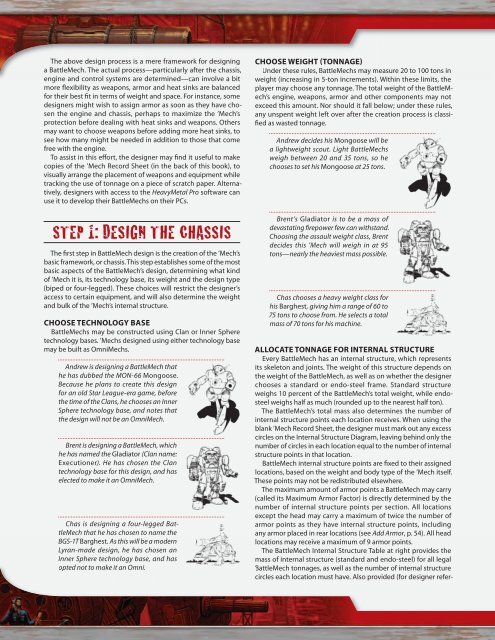the shape of things to come
the shape of things to come
the shape of things to come
Create successful ePaper yourself
Turn your PDF publications into a flip-book with our unique Google optimized e-Paper software.
The above design process is a mere framework for designing<br />
a BattleMech. The actual process—particularly after <strong>the</strong> chassis,<br />
engine and control systems are determined—can involve a bit<br />
more fl exibility as weapons, armor and heat sinks are balanced<br />
for <strong>the</strong>ir best fi t in terms <strong>of</strong> weight and space. For instance, some<br />
designers might wish <strong>to</strong> assign armor as soon as <strong>the</strong>y have chosen<br />
<strong>the</strong> engine and chassis, perhaps <strong>to</strong> maximize <strong>the</strong> ’Mech’s<br />
protection before dealing with heat sinks and weapons. O<strong>the</strong>rs<br />
may want <strong>to</strong> choose weapons before adding more heat sinks, <strong>to</strong><br />
see how many might be needed in addition <strong>to</strong> those that <strong>come</strong><br />
free with <strong>the</strong> engine.<br />
To assist in this eff ort, <strong>the</strong> designer may fi nd it useful <strong>to</strong> make<br />
copies <strong>of</strong> <strong>the</strong> ’Mech Record Sheet (in <strong>the</strong> back <strong>of</strong> this book), <strong>to</strong><br />
visually arrange <strong>the</strong> placement <strong>of</strong> weapons and equipment while<br />
tracking <strong>the</strong> use <strong>of</strong> <strong>to</strong>nnage on a piece <strong>of</strong> scratch paper. Alternatively,<br />
designers with access <strong>to</strong> <strong>the</strong> HeavyMetal Pro s<strong>of</strong>tware can<br />
use it <strong>to</strong> develop <strong>the</strong>ir BattleMechs on <strong>the</strong>ir PCs.<br />
STEP 1: DESIGN THE CHASSIS<br />
The fi rst step in BattleMech design is <strong>the</strong> creation <strong>of</strong> <strong>the</strong> ’Mech’s<br />
basic framework, or chassis. This step establishes some <strong>of</strong> <strong>the</strong> most<br />
basic aspects <strong>of</strong> <strong>the</strong> BattleMech’s design, determining what kind<br />
<strong>of</strong> ’Mech it is, its technology base, its weight and <strong>the</strong> design type<br />
(biped or four-legged). These choices will restrict <strong>the</strong> designer’s<br />
access <strong>to</strong> certain equipment, and will also determine <strong>the</strong> weight<br />
and bulk <strong>of</strong> <strong>the</strong> ’Mech’s internal structure.<br />
CHOOSE TECHNOLOGY BASE<br />
BattleMechs may be constructed using Clan or Inner Sphere<br />
technology bases. ’Mechs designed using ei<strong>the</strong>r technology base<br />
may be built as OmniMechs.<br />
Andrew is designing a BattleMech that<br />
he has dubbed <strong>the</strong> MON-66 Mongoose.<br />
Because he plans <strong>to</strong> create this design<br />
for an old Star League-era game, before<br />
<strong>the</strong> time <strong>of</strong> <strong>the</strong> Clans, he chooses an Inner<br />
Sphere technology base, and notes that<br />
<strong>the</strong> design will not be an OmniMech.<br />
Brent is designing a BattleMech, which<br />
he has named <strong>the</strong> Gladia<strong>to</strong>r (Clan name:<br />
Executioner). He has chosen <strong>the</strong> Clan<br />
technology base for this design, and has<br />
elected <strong>to</strong> make it an OmniMech.<br />
Chas is designing a four-legged BattleMech<br />
that he has chosen <strong>to</strong> name <strong>the</strong><br />
BGS-1T Barghest. As this will be a modern<br />
Lyran-made design, he has chosen an<br />
Inner Sphere technology base, and has<br />
opted not <strong>to</strong> make it an Omni.<br />
CHOOSE WEIGHT (TONNAGE)<br />
Under <strong>the</strong>se rules, BattleMechs may measure 20 <strong>to</strong> 100 <strong>to</strong>ns in<br />
weight (increasing in 5-<strong>to</strong>n increments). Within <strong>the</strong>se limits, <strong>the</strong><br />
player may choose any <strong>to</strong>nnage. The <strong>to</strong>tal weight <strong>of</strong> <strong>the</strong> BattleMech’s<br />
engine, weapons, armor and o<strong>the</strong>r components may not<br />
exceed this amount. Nor should it fall below; under <strong>the</strong>se rules,<br />
any unspent weight left over after <strong>the</strong> creation process is classifi<br />
ed as wasted <strong>to</strong>nnage.<br />
Andrew decides his Mongoose will be<br />
a lightweight scout. Light BattleMechs<br />
weigh between 20 and 35 <strong>to</strong>ns, so he<br />
chooses <strong>to</strong> set his Mongoose at 25 <strong>to</strong>ns.<br />
Brent’s Gladia<strong>to</strong>r is <strong>to</strong> be a mass <strong>of</strong><br />
devastating fi repower few can withstand.<br />
Choosing <strong>the</strong> assault weight class, Brent<br />
decides this ’Mech will weigh in at 95<br />
<strong>to</strong>ns—nearly <strong>the</strong> heaviest mass possible.<br />
Chas chooses a heavy weight class for<br />
his Barghest, giving him a range <strong>of</strong> 60 <strong>to</strong><br />
75 <strong>to</strong>ns <strong>to</strong> choose from. He selects a <strong>to</strong>tal<br />
mass <strong>of</strong> 70 <strong>to</strong>ns for his machine.<br />
ALLOCATE TONNAGE FOR INTERNAL STRUCTURE<br />
Every BattleMech has an internal structure, which represents<br />
its skele<strong>to</strong>n and joints. The weight <strong>of</strong> this structure depends on<br />
<strong>the</strong> weight <strong>of</strong> <strong>the</strong> BattleMech, as well as on whe<strong>the</strong>r <strong>the</strong> designer<br />
chooses a standard or endo-steel frame. Standard structure<br />
weighs 10 percent <strong>of</strong> <strong>the</strong> BattleMech’s <strong>to</strong>tal weight, while endosteel<br />
weighs half as much (rounded up <strong>to</strong> <strong>the</strong> nearest half <strong>to</strong>n).<br />
The BattleMech’s <strong>to</strong>tal mass also determines <strong>the</strong> number <strong>of</strong><br />
internal structure points each location receives. When using <strong>the</strong><br />
blank ’Mech Record Sheet, <strong>the</strong> designer must mark out any excess<br />
circles on <strong>the</strong> Internal Structure Diagram, leaving behind only <strong>the</strong><br />
number <strong>of</strong> circles in each location equal <strong>to</strong> <strong>the</strong> number <strong>of</strong> internal<br />
structure points in that location.<br />
BattleMech internal structure points are fi xed <strong>to</strong> <strong>the</strong>ir assigned<br />
locations, based on <strong>the</strong> weight and body type <strong>of</strong> <strong>the</strong> ’Mech itself.<br />
These points may not be redistributed elsewhere.<br />
The maximum amount <strong>of</strong> armor points a BattleMech may carry<br />
(called its Maximum Armor Fac<strong>to</strong>r) is directly determined by <strong>the</strong><br />
number <strong>of</strong> internal structure points per section. All locations<br />
except <strong>the</strong> head may carry a maximum <strong>of</strong> twice <strong>the</strong> number <strong>of</strong><br />
armor points as <strong>the</strong>y have internal structure points, including<br />
any armor placed in rear locations (see Add Armor, p. 54). All head<br />
locations may receive a maximum <strong>of</strong> 9 armor points.<br />
The BattleMech Internal Structure Table at right provides <strong>the</strong><br />
mass <strong>of</strong> internal structure (standard and endo-steel) for all legal<br />
BattleMech <strong>to</strong>nnages, as well as <strong>the</strong> number <strong>of</strong> internal structure<br />
circles each location must have. Also provided (for designer refer-


